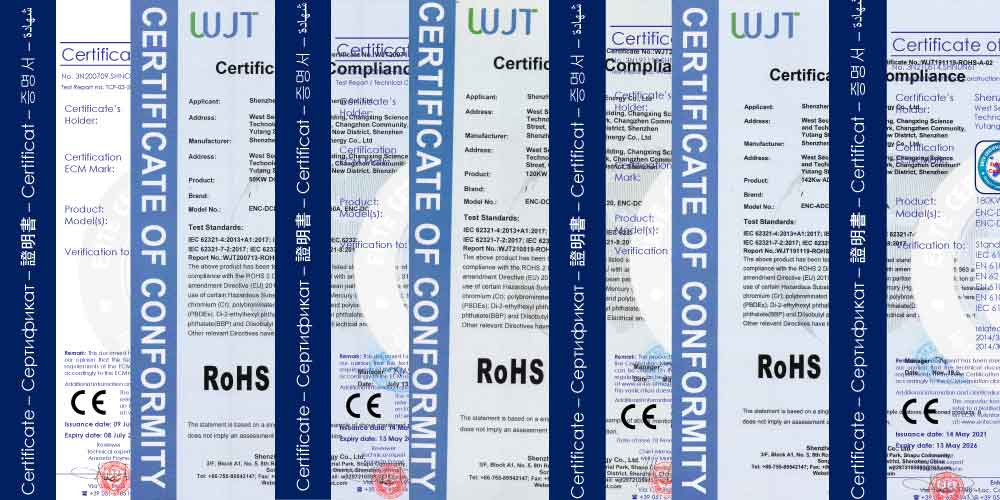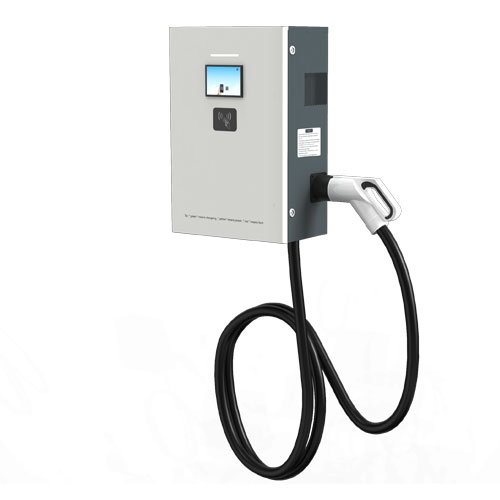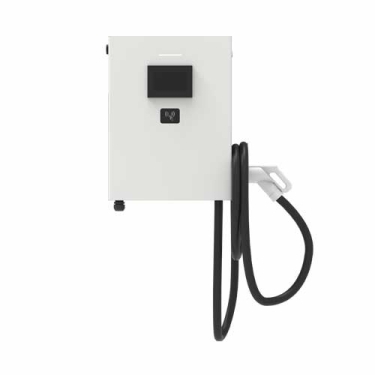Parameters | Requirements | ||
General Requirements | |||
EV Charger Type | DC | ||
Charger Capacity | 40KW | ||
Equipment size | L650*W440*H190(mm) | ||
Product Model NO. | ENC-DCB040A | ANSI-DCB040A | JIS-DCB040A |
Mounting | Wall-Mounted | ||
Input Requirements | |||
AC Supply System | Three-Phase, 5 Wire AC system | ||
Nominal Input Voltage | AC380V±15% | ||
Input Frequency | 45-65Hz | ||
Environmental Requirements | |||
Ambient Temperature Range | -25 to 55°C | ||
Ambient Humidity | 5 to 95% | ||
Storage Temperature | -40 to 70°C | ||
Mechanical Requirements | |||
IP Ratings | IP 54 | ||
Cooling | Air-cooled | ||
Output Requirements | |||
Number of Outputs | 1 | ||
Type of Each Output | 200-1000VDC | ||
Single Output Max.Current | 132 Amp | ||
Power Factor | ≥0.99(50% load above) | ||
User Interface & Display Requirements | |||
Display & Touch-Screen Size | 7 Inches Touch Screen with Shell | ||
User Authentication | QR Code/RFID Card /Password Login | ||
Metering Information | Consumption Units | ||
Communication Requirements | |||
Communication between EVSE and Central server | OCPP 1.6J Protocol (Optional) | ||
Interface between Charger and CMS | Ethernet/3G/4G/WIFI (Optional) | ||
Protection & Safety Requirements | |||
Executive Standard | IEC 62196 2017, IEC 61851 2017, SAE J1772,CHAdeMO etc. | ||
Safety Parameters | Over Current, Over Voltage, Under Voltage, Residual Current, Surge Protection, Leakage Protection, Short Circuit, Over Temperature, etc. | ||
Product Attributes
Product Description
40KW wall-mounted type DC Chargring Pile Features:
1、Delicate appearance, simple operation, convenient installation;
2、High effiffifficiency, reliable and stable performance;
3、Friendly interaction interface, 4.3-inch color touch screen(optional);
4、Support GBT/CCS-2/CCS-1/CHAdemo connector (or socket)(optional);
5、Support RFID card/ocpp1.6J(optional);
6、Support Plug&Play;
7、Overload integrated Protection;
40KW wall-mounted type DC Chargring Pile Applicable Scenes:
They are suitable for occasions such as city special charging stations that provide charging for bus, taxi, public service vehicles, sanitation vehicles,logistics vehicles, etc.; city public charging stations that provide charging for private cars, commuter, bus; intercity highway charging stations and other occasions that need special DC fast charging.
Production Certification

FAQ
Q1: Are you trading company or manufacturer?
A: We are a professional electric car charger manufacturer and source factory.
Q2: what is the lead time?
A: Usually, 15-20 working days to produce.
Q3: Can we ask you to print our logo into chargers? Can the color of the plug and wire be customized according to our requirements?
A: Yes. We support OEM/ODM production.
Q4: How about your product quality? What should I do if something goes wrong?
A: First of all, we sell our products for many years, and we have a professional engineering team in this field. Moreover, our products have been strictly inspected and repeatedly tested before leaving the factory, and the good and good rate of the varieties has reached 99.98%. Finally, we have service providers in some areas, please contact us for more information
Q5: What is your quality control system?
A: Complete all incoming material inspection, process inspection, and final inspection; 30 test procedures will be done before the goods leave the factory, and charging test videos will be sent; products have CE, ROHS, FCC, UL, KC certification.
Q6: Can I install the EV charger by myself?
A: Yes, but we suggest the user contact a professional electrician for installation to avoid potential safety hazards.
Q7:Why my charging power is lower than the specification?e?
A: Because during the charging session, a few factors will influence the output. Here is some potential reason:
①The BMS(Battery management system) of the car controls the charging session. ②The Max allowed current was set and limited through your APP. For more details, please query us at sales@hjlcharger.comQ8: How much time is required to fully charge my car using this charger?
A: The charging speed is determined by three factors working in conjunction: the On Board Charging (OBC) System, the maximum current allowed by the charging cable, and the EVSE. As an illustration, if the EV's maximum allowed power is 30KW and the battery capacity is 60KWh, it would take approximately 2 hours to charge the battery fully.
Q9: What is dynamic load balancing and why do I need that?
A: Dynamic load balancing is a technique that distributes the electrical load across multiple charging stations based on real-time demand. This helps prevent the electrical grid's overload and ensures that each charging station receives appropriate power.
Dynamic load balancing technology can help distribute the available power among multiple EV chargers in real-time, optimizing available power and reducing the risk of overloading the grid. This can help prevent power outages and reduce the need for costly grid upgrades. Additionally, dynamic load Balancing can help reduce charging times and improve the overall charging experience for EV drivers, making it a valuable feature for both residential and commercial charging applications.



